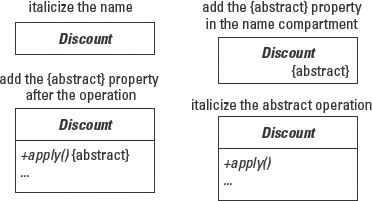Glossary
abstract class
A class that cannot be directly instantiated because at least one operation lacks a method (implementation). Any superclass may be abstract because the implementation can be provided by a subclass. An abstract class is identified either by italicizing the class name or by adding the property {abstract} to the operations that do not have a corresponding method, that is, the operations that prevent the class from being instantiated. Contrast: concrete class.

Figure GL-1: Notation options for abstract classes.
abstraction
A representation of an entity that includes only those properties that support the proposed use of the representation, and sufficient to distinguish it from all other kinds of entities. An abstraction defines a boundary relative to the perspective of the viewer. Also, the process of choosing information to include in the representation of an entity based on how and why the user plans to use the representation.
action
An action is the fundamental unit of behavior specification and represents some transformation or processing in the modeled system, be it a computer system or a real-world system. Actions are contained in an activity-expression, which provide their context. An action typically results in a change in the state of the system, and can be realized by sending a message to an object, modifying an attribute value, or by modifying a link. ...
Get UML™ Bible now with the O’Reilly learning platform.
O’Reilly members experience books, live events, courses curated by job role, and more from O’Reilly and nearly 200 top publishers.

